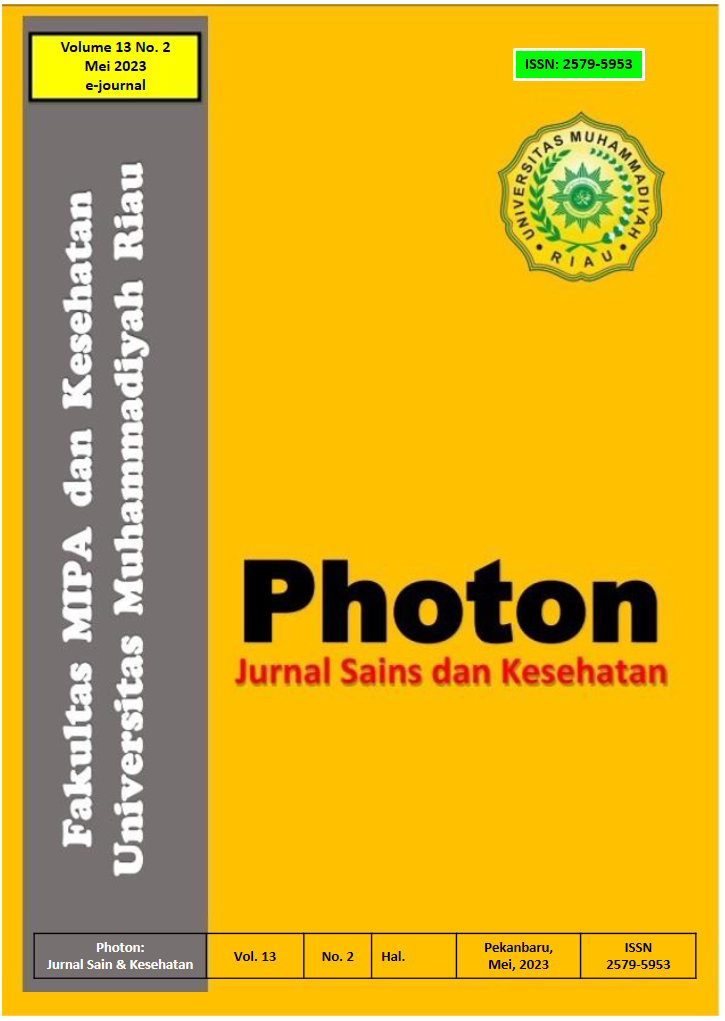Uji Karakteristik Elektrolit Ampas Kulit Nanas dengan Penambahan MgCl2, NaCl, dan KCl
DOI:
 https://doi.org/10.37859/jp.v13i2.4394
https://doi.org/10.37859/jp.v13i2.4394
Abstract
This study aims to determine the electrolyte characteristics of pineapple skin pulp which is used for the manufacture of electrolytes in bio-batteries as an alternative energy source. The electrodes used are zinc (Zn) and copper (Cu). The parameters measured are voltage, current strength and the length of the LED lamp flame. The variations used are pure pineapple peel pulp, pineapple peel pulp with the addition of NaCl, KCl, MgCl2 salts with mass variations of 0.25, 0.50, 0.75, 1, 1.25 and 1.50 grams. The results of the research of pineapple skin paste added with salt produced a voltage from 2.684 volts - 3.923 volts, a strong current from 0.52 mA - 0.79 mA and an LED lamp flame from 2 hours - 15 hours. The voltage value on pure pineapple 2,517 volts with the addition of MgCl2 experienced an increase in voltage of 52.82%, the voltage value with the addition of NaCl increased by 55.83% and the voltage value with the addition of KCl increased by 58.84%. The strong current value in pure pineapple 0.50 mA with the addition of MgCl2 experienced an increase in current strength of 52.76%, the strong value of current with the addition of NaCl increased by 56.01% and the strong value of current with the addition of KCl increased by 58.96%. The length of flame of LED lamps produced in the addition of MgCl2, NaCl and KCl was 71.27%, 84.33%, and 87.75% experienced an increase in time from the pulp of pure pineapple skin.The results showed that the greater the addition of salt mass to the pulp of pineapple skin, the greater the result of voltage, strong current and flame of the LED lamp on the electrolyte. Testing pineapple skin pulp can produce electrical energy that can be used as electrolyte manufacturing.
Downloads
References
Atina. (2015). Tegangan Dan Kuat Arus Listrik Dari Sifat Asam Buah. Saimantika, 12(2), 28–42.
Fadilah, S., Rahmawati, R., & Pkim, M. (2015). Pembuatan Biomaterial dari Limbah Kulit Pisang ( Musa Paradisiaca ). Prosiding Simposium Nasional Inovasi Dan Pembelajaran Sains 2015 (SNIPS 2015), 8(1), 45–48.
Fitrya, N., Wirman, S. P., & Rahayu, R. D. (2021). Environmentally Friendly Emergency Lighting System Using Bio Batteries from Pineapple Skin Waste as Energy Source. Jurnal Ilmu Fisika (JIF), 13(2), 118–125.
Mah Bengi, F., Wahyuni, A. S., Syamsuryani, W., & Mustika, D. (2018). Perbandingan arus dan tegangan larutan elektrolit berbagai jenis garam. Jurnal Pendidikan Fisika Dan Sains, 1(01), 32–36. https://ejurnalunsam.id/index.php/JPFS/article/view/1724
Masthura, & Abdullah. (2021). Pemanfaatan Sari Nenas Sebagai Sumber Energi Alternatif Pembuatan Bio-Baterai. JURNAL ILMIAH PENDIDIKAN TEKNIK ELEKTRO, 5(1), 51–58.
Purwati, W., & Harjono, T. (2017). Analisis Pemanfaatan Limbah Kulit Pisang Sebagai Energi Alternatif Pada Batterai. Jurnal Teknik Energi, 13(2), 61–67.
Rettob, A. L., & Karbeka, M. (2019). Pengaruh Konsentrasi Larutan Hf Pada Proses Preparasi Terhadap Kadar Unsur Bahan Magnetik Pasir Besi. Walisongo Journal of Chemistry, 2(1), 6. https://doi.org/10.21580/wjc.v3i1.3877
Sumanzaya, T., Supriyanto, A., & Pauzi, G. A. (2019). Analisis Karakteristik Elektrik Onggok Singkong sebagai Pasta Bio-Baterai. Jurnal Teori Dan Aplikasi Fisika, 7(2), 231–238. https://doi.org/10.23960/jtaf.v7i2.1982
Yanasari, R., & Refelita, F. (2017). PEMANFAATAN KULIT PISANG (MUSA PARADISIACA) SEBAGAI PEMBUATAN BATERAI PADA PRAKTIKUM ELEKTROKIMIA DI MAN 1 PEKANBARU. Konfigurasi, 1(2), 163–170.
Downloads
Published
How to Cite
Issue
Section
License
Each article is copyrighted © by its author(s) and is published under license from the author(s).
When a paper is accepted for publication, authors will be requested to agree with the Creative Commons Attribution-Noncommercial-No Derivative Works 4.0










